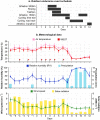Heat preparedness and exertional heat illness in Paralympic athletes: A Tokyo 2020 survey
- PMID: 37332304
- PMCID: PMC10274519
- DOI: 10.1080/23328940.2022.2147364
Heat preparedness and exertional heat illness in Paralympic athletes: A Tokyo 2020 survey
Abstract
Paralympic athletes may be at increased risk for exertional heat illness (EHI) due to reduced thermoregulatory ability as a consequence of their impairment. This study investigated the occurrence of heat-stress related symptoms and EHI, and the use of heat mitigation strategies in Paralympic athletes, both in relation to the Tokyo 2020 Paralympic Games and previous events. Paralympic athletes competing in Tokyo 2020 were invited to complete an online survey five weeks prior to the Paralympics and up to eight weeks after the Games. 107 athletes (30 [24-38] years, 52% female, 20 nationalities, 21 sports) completed the survey. 57% of respondents had previously experienced heat-stress related symptoms, while 9% had been medically diagnosed with EHI. In Tokyo, 21% experienced at least one heat-stress related symptom, while none reported an EHI. The most common symptom and EHI were, respectively, dizziness and dehydration. In preparation for Tokyo, 58% of respondents used a heat acclimation strategy, most commonly heat acclimatization, which was more than in preparation for previous events (45%; P = 0.007). Cooling strategies were used by 77% of athletes in Tokyo, compared to 66% during past events (P = 0.18). Cold towels and packs were used most commonly. Respondents reported no medically-diagnosed EHIs during the Tokyo 2020 Paralympic Games, despite the hot and humid conditions in the first seven days of competition. Heat acclimation and cooling strategies were used by the majority of athletes, with heat acclimation being adopted more often than for previous competitions.
Keywords: Heat acclimation; adapted sports; cooling; heat mitigation; impairment; para-athletes.
© 2022 The Author(s). Published by Informa UK Limited, trading as Taylor & Francis Group.
Conflict of interest statement
No potential conflict of interest was reported by the author(s).
Figures







Similar articles
-
Heat-related issues and practical applications for Paralympic athletes at Tokyo 2020.Temperature (Austin). 2019 Jun 27;7(1):37-57. doi: 10.1080/23328940.2019.1617030. eCollection 2020. Temperature (Austin). 2019. PMID: 32166104 Free PMC article. Review.
-
Incidence and factor analysis for the heat-related illness on the Tokyo 2020 Olympic and Paralympic Games.BMJ Open Sport Exerc Med. 2023 Apr 7;9(2):e001467. doi: 10.1136/bmjsem-2022-001467. eCollection 2023. BMJ Open Sport Exerc Med. 2023. PMID: 37051574 Free PMC article.
-
Strategies and factors associated with preparing for competing in the heat: a cohort study at the 2015 IAAF World Athletics Championships.Br J Sports Med. 2017 Feb;51(4):264-270. doi: 10.1136/bjsports-2016-096579. Epub 2016 Nov 4. Br J Sports Med. 2017. PMID: 27815238 Free PMC article.
-
Ambient Conditions Prior to Tokyo 2020 Olympic and Paralympic Games: Considerations for Acclimation or Acclimatization Strategies.Front Physiol. 2019 Apr 24;10:414. doi: 10.3389/fphys.2019.00414. eCollection 2019. Front Physiol. 2019. PMID: 31068829 Free PMC article.
-
Hydration and Cooling Strategies for Paralympic Athletes : Applied Focus: Challenges Athletes May Face at the Upcoming Tokyo Paralympics.Curr Nutr Rep. 2020 Sep;9(3):137-146. doi: 10.1007/s13668-020-00317-1. Curr Nutr Rep. 2020. PMID: 32472366 Review.
Cited by
-
The Prevalence of Cardiovascular Diseases in Paralympic Athletes.Healthcare (Basel). 2023 Apr 4;11(7):1027. doi: 10.3390/healthcare11071027. Healthcare (Basel). 2023. PMID: 37046954 Free PMC article. Review.
-
The Potential Impact of Heat on Athletes' Sleep at the Paris 2024 Olympics and Paralympics Games.Sleep Sci. 2024 Oct 7;18(2):e236-e240. doi: 10.1055/s-0044-1791236. eCollection 2025 Jun. Sleep Sci. 2024. PMID: 40672895 Free PMC article.
-
Humid Heat Equally Impairs Maximal Exercise Performance in Elite Para-Athletes and Able-Bodied Athletes.Med Sci Sports Exerc. 2023 Oct 1;55(10):1835-1844. doi: 10.1249/MSS.0000000000003222. Epub 2023 May 22. Med Sci Sports Exerc. 2023. PMID: 37227231 Free PMC article.
-
Mixed pre-cooling improves thermal strain but not running performance in female endurance athletes exercising in the heat across the menstrual cycle.Temperature (Austin). 2025 Feb 22;12(2):133-148. doi: 10.1080/23328940.2025.2465023. eCollection 2025. Temperature (Austin). 2025. PMID: 40330618 Free PMC article.
-
Performance Benefits of Pre- and Per-cooling on Self-paced Versus Constant Workload Exercise: A Systematic Review and Meta-analysis.Sports Med. 2024 Feb;54(2):447-471. doi: 10.1007/s40279-023-01940-y. Epub 2023 Oct 6. Sports Med. 2024. PMID: 37803106 Free PMC article.
References
-
- Lei T-H, Wang F.. Looking ahead of 2021 Tokyo Summer Olympic Games: how Does Humid Heat Affect Endurance Performance? Insight into physiological mechanism and heat-related illness prevention strategies. J Therm Biol. 2021;99:102975. - PubMed
-
- Périard JD, Eijsvogels TMH, Daanen HAM. Exercise under heat stress: thermoregulation, hydration, performance implications, and mitigation strategies. Physiol Rev. 2021;101:1873–1979. - PubMed
-
- Price MJ, Trbovich M. Thermoregulation following spinal cord injury. In: Romanovsky A, editor. Handbook of Clinical Neurology Thermoregulation: from Basic Neuroscience to Clinical Neurology, Part II. Amsterdam, The Netherlands: Elsevier; 2018. p. 799–820. - PubMed
LinkOut - more resources
Full Text Sources
Other Literature Sources
Miscellaneous
